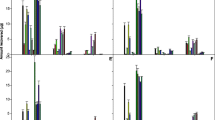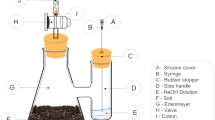Abstract
Cauliflower crops were grown in several regions and seasons (spring and summer). Five days after planting, the plants were treated against the root fly by pouring onto soil around the plant stem an emulsion of chlorfenvinphos [2-chloro-1-(2,4-dichlorophenyl) ethenyl diethyl phosphate] in water. The fields were divided into plots. Onto each plot, one of the organic fertilizers, city refuse compost, mushroom cultivation compost, or cow manure was applied at the rate of 100 tons/ha, 1 or 3.5 months before the insecticide treatment. There were also control plots which were not treated with any of the organic fertilizers. During the first 50 days crop period which followed the insecticide treatment, the chlorfenvinphos soil concentrations were always greater in the organic fertilizer-treated plots, than in the untreated ones (controls). The intensity of the organic fertilizers effect as to the increase of chlorfenvinphos soil persistence was in the following increasing order: city refuse compost < cow manure < mushroom cultivation compost. The organic fertilizer effects were greater when they had been soil-incorporated 3.5 months—instead of 1 month—before the chlorfenvinphos soil treatment. The increase of the insecticide soil concentrations—due to the organic fertilizers treatments—should increase the plant protection efficiency during the period of the first 50 days, during which time the young plants are the most sensitive to insects. During the following period of the 2 or 3 last crop weeks, the effects of the organic fertilizers onto the rate of chlorfenvinphos soil metabolism were levelled off; at harvest, the very low soil-resting residues were similar in the organic fertilizers treated and untreated plots. At harvest, no chlorfenvinphos nor its metabolites were detected in the ‘flower’ of cauliflower of all the plots, the analytical limit of sensitivity being 0.02 mg kg−1 fresh weight for all of these compounds.
Similar content being viewed by others
References
Beynon KI, Davies L, Elgar K (1966) Analysis of crops and soil for residues of diethyl 1-(2,4-dichlorophenyl)-2-chlorovinyl phosphate. II. Results. J Sci Fd Agric 17:167–174
Doyle RC, Kaufmann DD, Burt GW (1978) Effect of dairy manure and sewage sludge on 14C-pesticide degradation in soil. J Agric Fd Chem 26:987–989
Honnay JP (1990) Scientific Adviser at the Institute for Research in Industry and Agronomy, IRSIA-IWONL, Brussels, Belgium
Lichtenstein EP, Schultz KR (1959) Persistence of some chlorinated hydrocarbon insecticides as influenced by soil types, rate of application and temperature. J Econ Entomol 52:124–131
Lichtenstein EP, Liang TT, Koeppe MK (1982) Effects of fertilizers, captafol, and atrazine on the fate and translocation of 14C-fonofos and 14C-parathion in a soil-plant microcosm. J Agric Fd Chem 30:871–878
Pik AJ, Peake E, Strosher MT, Hodgson GW (1977) Fate of 3,6-dichloropicolinic acid in soils. J Agric Fd Chem 25:1054–1061
Rouchaud J, Gustin F, Van de Steene F, Pelerents C, Gillet J, Benoit F, Ceustermans N, Vanparys L (1989) Metabolism of chlorfenvinphos in both soil and plant of cauliflower and brussels sprouts field crops. Bull Environ Contam Toxicol 43:920–928
SAS Institute Inc (1984, 1986) Cary, NC 27512
Author information
Authors and Affiliations
Rights and permissions
About this article
Cite this article
Rouchaud, J., Gustin, F., Benoit, F. et al. Influence of cow manure and composts on the effects of chlorfenvinphos on field crops. Arch. Environ. Contam. Toxicol. 22, 122–129 (1992). https://doi.org/10.1007/BF00213310
Received:
Revised:
Issue Date:
DOI: https://doi.org/10.1007/BF00213310




